Periodontal disease can be seen in 70% of cats over three years old.
Fortunately, there are things we as owners can do to keep our cat’s teeth in tip top condition. Find out more about routine oral care, and dental visits to the vets.
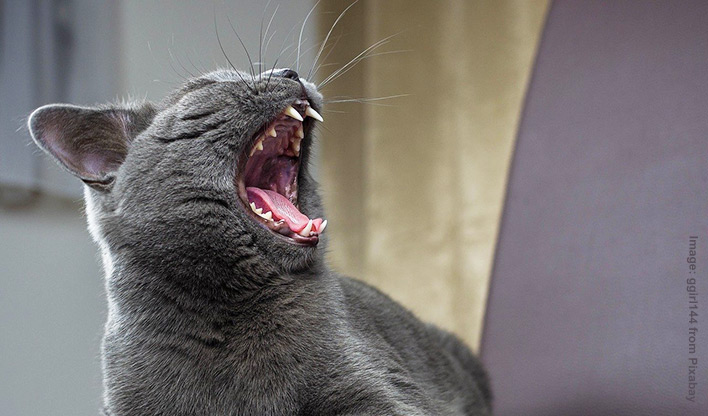
Periodontal disease can be seen in 70% of cats over three years and can cause your beloved moggie pain and discomfort. Fortunately, there are things as owners we can do to keep your cat’s teeth in tip top condition. It can be tricky to know where to start, but this article will give you more confidence with the day-to-day care of your cat's teeth, and explains what a 'dental' at the vets involves.
As you are probably aware, cats can be reluctant to accept medical care in general, and dental care is no different. A calm, cat-centred and consistent approach is required to get the most out of caring for the oral hygiene of your cat.
What do I need to know about my cat’s teeth?
Cats, like all domestic animals, have two sets of teeth during their life. Their baby (deciduous) teeth come through first, followed by a set of permanent teeth at 4 to 7 months of age.
Cats have 26 deciduous teeth and 30 permanent teeth, made up of incisors, two very sharp canine teeth, pre-molars and molars.
Cats are obligate carnivores by nature, which means their diet must consist of animal products. This means their teeth are adapted to hunt and eat prey:
- Incisors help to grab prey, or food
- Canines are there to kill the prey
- Pre-molars and molars are there to chew or grind down food
As well as for the purpose of eating, a cat’s teeth help them to defend themselves and assist in their grooming routine.
As cats get older there is a natural build-up of plaque on the teeth. Plaque is a sticky film containing bacteria, which, over time, hardens into tartar (calculus). This can lead to periodontal disease and other oral health problems.
How to properly examine your cat’s teeth
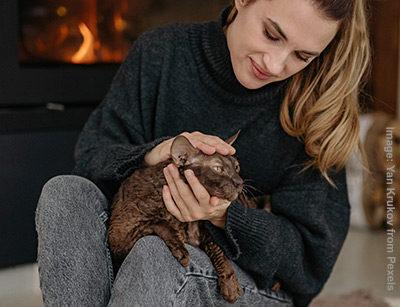 Your cat might be unwilling to let you examine his teeth. After all, none of us are keen on the dentist! If he allows it, get him to sit with you and start by stroking him so he feels a bit more comfortable. Gently hold the top of his head with one hand while the other hand carefully lifts up his lips. Cats are more receptive with less restraint, so less is more in this case. Once you’ve finished looking, give him a little reward, such as extra fuss or playtime.
Your cat might be unwilling to let you examine his teeth. After all, none of us are keen on the dentist! If he allows it, get him to sit with you and start by stroking him so he feels a bit more comfortable. Gently hold the top of his head with one hand while the other hand carefully lifts up his lips. Cats are more receptive with less restraint, so less is more in this case. Once you’ve finished looking, give him a little reward, such as extra fuss or playtime.
While checking, make an assessment of the general colour of his gums – they should be a nice salmon pink colour. Do any of the edges where tooth meets gum look bright red? Also see how much plaque and tartar he has on his teeth.
What are the symptoms of dental disease in my cat?
You may have heard of the term ‘periodontal disease’. This is the most common dental disease in cats (and dogs) and occurs when inflammation damages the supporting structures of the tooth – the ‘periodontal ligaments’ that hold the tooth in the jaw.
Periodontal disease can cause pain and inflammation in your cat’s mouth. In addition, the bacteria causing periodontal disease can cause problems in other areas of the body, and increase the risk of heart, kidney, and liver disease.
Cats are notoriously good at hiding pain, and with dental disease they are no different. Whilst we know periodontal disease is extremely painful, with the early stages it is likely you will not notice your cat showing any obvious symptoms. Usually, we see the following symptoms in advanced periodontal disease:
- Eating less, not eating at all or dropping food from the mouth
- Loose teeth
- Broken or missing teeth
- Bleeding or red gums (gingivitis)
- Bad breath
- Vocalising, such as growling
- Behaviour changes, ie hiding or showing aggression
- Ulcers on gums
- Drooling
- Not grooming themselves properly
What other dental health conditions can affect my cat?
Another dental disease common in cats is referred to as ‘feline resorptive lesions’. This is where the body starts to absorb the tooth, causing damage and pain. The cause of this is unknown, but it is the most common oral condition after periodontal disease.
Unfortunately, active, playful cats can sometimes take a bit of a tumble, so fractured teeth are commonly seen in a veterinary practice. If you think your cat has a fractured tooth, bring him to the vet as soon as possible. Broken teeth can be extremely painful and are likely to become infected by bacteria, so they usually require removal.
How can I take good care of my cat’s teeth?
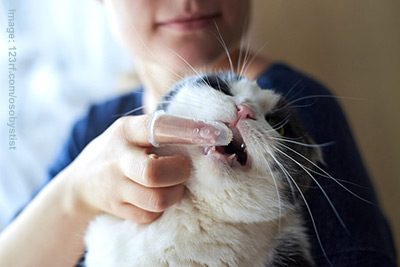 Can I clean my cat’s teeth?
Can I clean my cat’s teeth?
Brushing your cat’s teeth on a daily basis can help to reduce plaque.
Firstly, you need to buy a toothpaste suitable for your cat. There are many toothpastes available on the market, but one recommended by your vet is best. It’s a good idea to buy some silicone finger brushes designed for your cat’s mouth, as human toothbrushes are too large. Make sure you always clean the brush well with soap and water after use.
If your cat is comfortable with his mouth being touched, then you can apply some toothpaste to the back teeth and work forwards with the brush. Brush gently and do your best to cover all surfaces of the teeth and towards the top of the gums.
If your cat becomes a bit impatient and wriggly, let him walk away. You will be more successful if you gently build the brushing time up with your cat.
Other ways to help keep your cat’s teeth clean
As well as brushing, there are other methods that are effective at helping to keep your cat’s teeth clean.
Regular dental check-ups at the vets, perhaps once or twice a year, are a great way of spotting problems before they get worse.
In addition, try to limit the amount of treats your cat receives. Like human treats, cat treats can be high in sugar which can be damaging for your cat’s oral health. Their main source of food should always be a complete diet.
There are some commercial dental diets available online and in pet stores. These dental diets have been shown to reduce the build-up of plaque and tartar on your cat’s teeth. However, this should be done in addition to cleaning your cat’s teeth, not as a replacement.
What dental care options can a vet offer?
Veterinary professionals can offer advice on the dental care of your cat. They can also recommend and perform dental x-rays, scale and polishes, and extractions if needed.
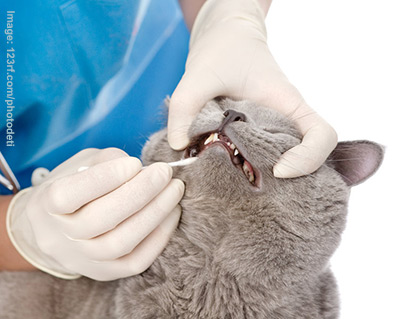 What does a ‘dental’ at the vets involve?
What does a ‘dental’ at the vets involve?
A dental for your cat will be completed under a general anaesthetic, meaning they will be asleep throughout the whole procedure. They will be given pain-relief and monitored by a veterinary nurse while the vet carries out the examination and procedure.
A dental is a great opportunity to have a really good look at your cat’s teeth, as it’s unlikely the vet will be able to examine his mouth fully when he’s awake! Your cat’s teeth will be examined individually, the gum line probed, and any areas of abnormality catalogued.
Your vet may offer your cat dental x-rays, which are a great way of getting an image of the inside of your cat’s teeth. Dental x-rays are also used to get an image of what’s going on below the gum line – this is particularly helpful for resorptive lesions.
If your cat has periodontitis, fractured teeth, or resorptive lesions, they may require extractions - your vet will discuss these with you. If this happens, they may put some stitches into your cat’s mouth to help reduce bleeding.
What is the aftercare following a dental?
Most cats go home the same day as their dental. Make sure you follow all aftercare instructions your vet gives you.
Your cat might be a bit sleepy after waking up from his anaesthetic, so keep him somewhere warm and cosy, with no drafts. It can be difficult for cats to regulate their body temperature first thing after they wake up, so a blanket might be needed.
Your cat can sip water after their dental. Do not be alarmed if there’s a little bit of blood in the water bowl, but if the bleeding hasn’t stopped after a while or you think it’s getting worse, ring your vet.
If your cat has had extractions, offer them some soft food that doesn’t require much chewing for the few days following the dental.
Make sure you attend any aftercare appointments with your veterinary practice.
FAQ’s
Will my cat be okay with fewer teeth?
Yes, generally cats cope really well after a dental, even with multiple extractions. You may need to adapt their diet slightly to allow them to cope better with their food, for example offering wet food from pouches or cans or smaller kibble.
Why would my cat need dental extractions?
Damaged teeth from conditions such as gum disease will require extraction. The damage caused can result in the teeth becoming quite unstable. In other circumstances - such as fractured teeth - the nerves can become exposed which is extremely painful for your cat and extractions are a common solution to this problem.
Which toothpaste should I buy for my cat?
Any commercially-available toothpaste that is marketed as suitable for use in cats should be appropriate, but ideally choose one recommended by your vet. You can find toothpaste and finger brushes in many good pet shops.
My cat really hates his teeth being brushed. Is there anything I can do to let him allow me to brush his teeth?
Get your cat used to you touching around his head and mouth. The less restraint the better, so be gentle and calm around your cat. Your cat might see the toothbrush and toothpaste come out and run! In this case you could try leaving both toothbrush and toothpaste out where your cat can see and smell them, so that he gets used to them in the house.
Final thoughts
Keeping good oral hygiene should be an important part of your cat’s preventative healthcare regime. Brushing is the number one way to keep your cat’s mouth clean and healthy, combined with regular veterinary dental health check-ups. Dental diets can reduce plaque, but should not be used instead of brushing. If in doubt or you think your cat is showing any signs of dental pain, take your cat in to see your vet for professional dental advice and cleaning.
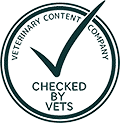 Contributer: Veterinary student Sophie Seagroatt under the supervision of Dr Joanna Woodnutt MRCVS of The Veterinary Content Company.
Contributer: Veterinary student Sophie Seagroatt under the supervision of Dr Joanna Woodnutt MRCVS of The Veterinary Content Company.
Published: September 2021

